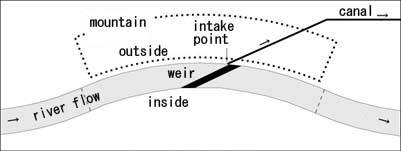japanese
Spatial relationship of weir with both river and mountain
-

It was thought that one of the traditional ways of taking river water into irrigation canals appeared in the landscape viewed from the intake points of the oblique weirs, which were not right-angled but slanting to the river channels. In order to verify this hypothesis, the spatial relationships of the weirs with both the river channels and the adjacent landforms were analyzed in 153 cases of 69 domestic watersheds by using topographical maps and aerial photographs. Those cases were classified into nine types according to the differences of both their relationships with adjacent clusters of summits and the meandering shapes of the river channels. In 90 cases classified into two types, the hypothesis was proved due to the basic compositions of the landscape based on the results of the analysis. On the other hand, the results showed the possibilities of qualitative differences in the landscape among the cases, according to the length and the degree of slant of weirs, the scale and the position of clusters of summits, the landform of the opposite shores, and the width and the shape of the river channels. The necessity of conducting in detail survey analysis of the compositions of the landscape actually viewed on-site became clear as the research task for the next phase.

-
more information
Murakami, S. (2014) : Research on possibilities of landscape at intake points of oblique weirs based on spatial relationships with both river channels and adjacent landforms: Journal of the Japanese Institute of Landscape Architecture:77(5)461-466







